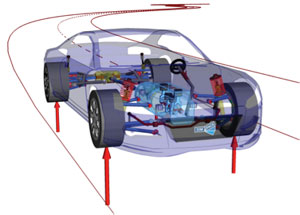Vehicle Dynamics
Msc in Design and Manufacturing of Sport Vehicles Systems
Part 1: Introduction
Εισαγωγή στο Matlab -Simulink
Ένα από τα αποδοτικά λογισμικά για την μοντελοποίηση και προσομοίωση δυναμικών συστημάτων είναι το λογισμικό Matlab και ειδικότερα το ειδικό εργαλείο προσομοίωσης, Simulink. Εδώ μπορείτε να βρείτε κάποιες διαθέσιμες σημειώσεις σχετικές μετά συγκεκριμένα λογισμικά, με τις οποίες μπορεί ο ενδιαφερόμενος εύκολα να προσαρμοστεί σε αυτά.
The Complete MATLAB Course: Beginner to Advanced!
A video course in order to understand the potenntial of the MATLAB software.
Introduction to Simulink - 1 D.O.F Spring-mass- damper system
Explore Simulink, an environment for multidomain simulation and Model-Based Design for dynamic and embedded systems. Through product demonstrations, you will see a high-level overview of the major capabilities and how you can use Simulink to design, simulate, implement, and test a variety of time-varying systems.
Part 2: Vertical Dynamics of Vehicles
Part 3: Longitudinal Vehicle Dynamics
Longitudinal Vehicle Dynamics Modeling using Simulink
An overview of vehicle modeling including how to model vehicle bodies, tires, brakes, and how to incorporate wind and terrain effects. This training is applicable for both combustion and electric engine student competition teams.
Multiple steps are involved in vehicle modeling, step one is generally modeling the frame and tires. A model is then used to demonstrate the longitudinal dynamics of the vehicle while the tires are modeled with tire magic formula using the Tire block from Simscape Driveline™. Speedometer and odometer functionalities are then added to measure and validate physical quantities in the model. Wind and terrain effects are then explored to show how they can impact the motion of the vehicle. The final step is to add manual brakes to the vehicle.
In summary, modeling vehicle bodies requires modeling tires, wind and terrain effects, and brakes.
Part 4: Multibody Dynamics using ADAMS
Adams Tutorial Kit
The enclosed Adams tutorial package is designed as a supplemental curriculum kit
for undergraduate Mechanical Engineering courses, including Design of Machinery,
Dynamics, Vehicle Dynamics, and Mechanical Design.
There are 26 examples in this Adams tutorial package, including some simple problems
like "four-bar linkage", "spring-damper system", and also some real industrial examples like
"Open differential" or "Gear Train System", which are created based on a new powerful set of
simulation modules in Adams called Adams/Machinery.
Several examples were developed from specific textbook problems, for example, the four
problems in section III were developed in reference to the textbook Design of Machinery
(Fifth Edition) by Robert L. Norton.
Getting Started Using ADAMS/Car
If you've never used ADAMS/Car before, this guide is a good place to start learning about
ADAMS/Car. As you work through the four step-by-step tutorials that we have provided
in this guide, you will learn most of the basic concepts and tasks that you can perform
using ADAMS/Car.
Here, you can find also a presentation explaining the potential of the MSC Adams Car.






